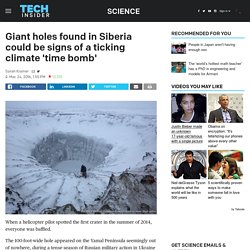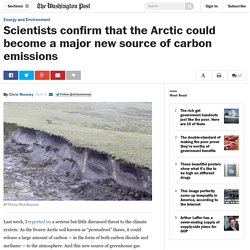

Can We Stop An Earthquake? Corals Are Dying on the Great Barrier Reef. Scientists have discovered an unprecedented die-off in the world's largest reef, the Great Barrier Reef, prompting the Australian government to issue its highest response level.

Diver surveys based off Cape York, Australia's northeastern tip, found up to 50 percent mortality in the reef from coral bleaching. Death among the organisms that build the reef's structure is most likely linked to rising temperatures in the ocean, the government announced. Huge craters appearing in Russia worry scientists. REUTERS/Vladimir Pushkarev/Russian Centre of Arctic Exploration When a helicopter pilot spotted the first crater in the summer of 2014, everyone was baffled.

The 100-foot-wide hole appeared on the Yamal Peninsula seemingly out of nowhere, during a tense season of Russian military action in Ukraine and international sanctions. And then more appeared. Lacking a better explanation, aliens and underground missiles were floated as possible theories, according to the Washington Post. But the truth is that the holes might come from a threat not even Mulder and Scully are equipped to handle: climate change.
Scientific American reports that Arctic zones are warming at a breakneck pace, and the summer of 2014 was warmer than average by an alarming 9 degrees Fahrenheit, according to another story in Nature. So how does frozen methane blow a 100-foot-wide hole in the ground? Scientists gained more evidence for this theory after an expedition to the bottom of the crater. Planet Earth - Mercy For Animals. 18 Doomed Tourist Attractions To Visit Before They're Lost Forever. Just over 100 years ago, 150 glaciers dominated this vast landscape.

As of 2014, there were only 24 remaining and by 2045, those are expected to melt as well. Many of the incredibly unique plant and animal species that call the park home require cold water, meaning the ecosystem will alter dramatically once the glaciers are gone. Scientists confirm that the Arctic could become a major new source of carbon ... AP Photo/Rick Bowmer Last week, I reported on a serious but little discussed threat to the climate system: As the frozen Arctic soil known as “permafrost” thaws, it could release a large amount of carbon — in the form of both carbon dioxide and methane — to the atmosphere.

And this new source of greenhouse gas emissions could be large enough that it could substantially undermine attempts to cut down on emissions from fossil fuels. Now, a new overview of what we know about the permafrost carbon problem has just come out in Nature, written by a group of 17 experts on the matter. In other words, this is probably the most thorough scientific look at the issue yet. And the researchers, led by Edward Schuur of Northern Arizona University, basically confirm that we have a serious problem — if not necessarily a catastrophe — on our hands. The bottom line is that the permafrost carbon problem doesn’t look like it’s going to just go away as researchers better refine their estimates. Al Gore: Averting the climate crisis. Geological_Timescale. Mapping the World's Air Pollution in Real Time. Worldwide, outdoor air pollution causes more than 3 million premature deaths each year.

While some cities have already reached hazardous levels of air pollution—such as Delhi, India, with smog practically covering the city daily—others are coming dangerously close. This is according to a new interactive map detailing most of the world’s air quality with real-time data. The map comes from Beijing-based environmental group Air Quality Index China, which worked with environmental protection agencies in more than 70 countries. It continuously collects data from more than 5,900 feeds coming from more than 8,000 air-quality-monitoring stations in nearly a thousand cities. Only feeds from government agencies are used, according to the website (“no DIY or amateur monitoring stations data” here).
Each city’s reading on the map is based on the concentration of fine particulate matter (PM 2.5) and rated on the U.S. A quick glance reveals the stark contrast between China and the United States. 4.5 Degrees.